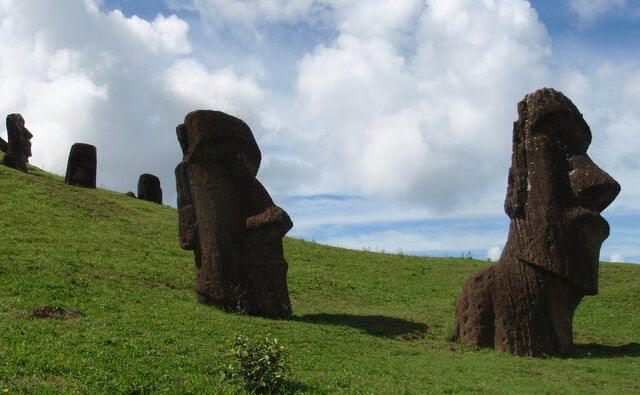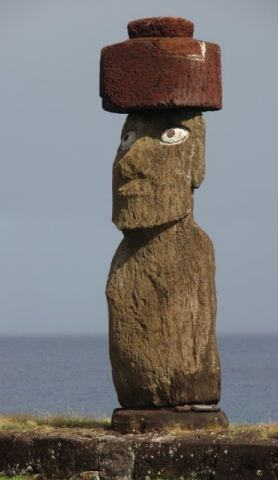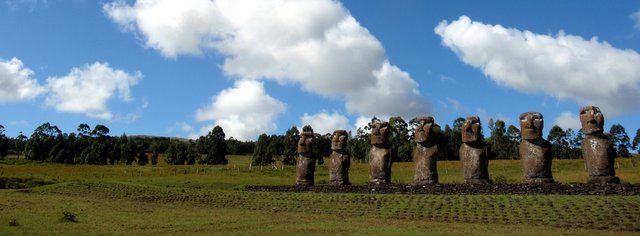
Moai at the Rano Raraku quarry
Rapa Nui – 13th April
I’m normally a happy enough flyer but for some reason getting on a plane and heading away from the mainland towards a very small target in the middle of the Pacific ocean is bothering me. It’s really not much different to crossing from Heathrow to JFK, but I’m just imagining the lack of rescue facilities at either end.
I’d hope everyone else isn’t thinking the same dark thoughts but it does seem a subdued crowd considering we’re all off somewhere exciting. It’s not until the captain announces it’s only 20 minutes to landing that people get a little livelier.

The island is tiny from the air and despite the island’s volcanic origin it has a soft and hilly terrain. I guess the plane descends so gradually as it’s the only plane in the sky. There’s only one flight a day to either Santiago or Tahiti, both around 5 hours away, so there’s minimal chance of your luggage getting lost.
At 3800m the runway is huge and in excellent condition, despite the small number of flights, as the US pay for the upkeep to allow for emergency Space Shuttle landings.
I was met at the airport with lei of purple and white flowers then transferred to my hotel. I presume everyone is out as I seem to be the only guest here. A restaurant next door to the hotel seemed surprised to see me but prepared a simple if expensive meal of mash and veg. Everything but fish, vegetables and bread is imported from the mainland, keeping food costs high.
The first afternoon I visited the nearby sacred cave Ana Kai Tangata, where the islanders used to bless their canoes. Cave paintings relating to the birdman cult are still visible on the ceiling, but it was just as interesting and slightly unnerving watching the huge waves crashing against the cliffs only a few meters away.
The island’s main museum is a short way out of town but well worth a visit. Our guide couldn’t translate too well so gave me a book which covered all the panels. It ran to 60+ pages but was very well written and really set the scene for the rest of the trip. It explained the types and construction methods of the moai, the formation of the islands and their unique flora and fauna.
The islanders believe in Mana and Tapu.
• Mana (the Force) is in all things and can be a measure of a person’s power, and it is increased by bringing up a large family or building Moai.
• Tapu (the Boundaries) are places or actions that lower Mana and possibly was the origin of the English word Tabu or Taboo.
Back in the village the small church was a mishmash of religious and traditional idols. Across the road the Craft Market sold a variety of stone and wood carvings, but my interest was more piqued by the poster advertising the second Rapa Nui Film Festival starting the next day: http://www.rapanuifilmfest.com/
Not being hungry I couldn’t face one of the local piles of food so instead went to Kotaro, one of the islands three Japanese restaurants. I was the only person in there for a while but was quickly ignored when some Japanese people turned up and the owner got to show off his language skills.
More and more Japanese people wandered in, so the food took an hour to arrive. It was actually quite good, but I was made to feel quite unwelcome compared to anyone Japanese.
The walk home was a bit disconcerting as the street lights are very dim. More light was cast on the ground by the stunning array of stars and the clear view of the Milky Way.
Navel of the World – 14th April
Today was the full day tour of the island. I think it’s designed primarily for people visiting for just a day from cruise ships as it covers most of the main sites, but I’m glad I’d been to the museum the day before and I’d be upset if I’d not seen Ahu Akivi the following day.
Ahu Vaihú
This was our first sight of a moai, and it was lying face down in the dirt, but thanks to the visit to the museum this wasn’t too disappointing:
• The 887 moai were built between 1000 and 1600AD from a variety of stones such as Basalt or Tuff. These were all brought from the Rano Raraku quarry up to 18km away. The oral traditions claim the statues walked by themselves but archaeologists such as Thor Heyerdahl and Pavel Pavel have suggested a number of theories. One was that they were wobbled into place, which would look vaguely like walking, but it’s more likely they were brought here on logs used as rollers.
• The size of a moai indicates time of construction rather than importance. They started at about 1.5m, but over time people wanted larger and larger statues to outdo their predecessors and the quarry contains some of up to 21m. Later moai had eyes made of coral and obsidian.
• The amount of stone, wood and food required for statues on this scale rapidly depleted the islands limited resources and resulted in wars over natural goods. During these conflicts a number of moai had been toppled during the resource conflicts, pushed face down to stop the mana flowing toward the owning family
Ahu Akahanga
Another construction site where obsidian is found, the only material on the island hard enough to work basalt, the main rock on the island.
In front of the altar were the remains of a house with a stone floor. Although small it would have slept up to eight people. Farther up the hill was a cave, also for eight. Originally caves were for poorer families, but as the island descends into conflict they became advantageous as defensive positions, rather than a mud hut with a grass roof.
Near the house was a traditional oven. This is a square formation of stones filled with fire used to heat up lava stones, which are then left to cook the leaf-wrapped food.

Moai at Ahu Tongariki
Ahu Tongariki
One of the most famous images of the island, this is 15 moai in a line. In the last century a tidal wave washed them inshore, pushing the 60 tonne stones about 100m inland. They have been moved back to their original position, with one left to show the extent of the wave.
Rano Raraku
We spent an hour walking through this quarry where the stones were broken away from the mountain and shaped. Around the lower levels were lots of partially finished moai, most with just the heads still showing above the ground. Further round the cliffside sits the islands only moai with legs, kneeling towards the island.
At the base of the quarry mountain we sat down for a BBQ lunch including rice, salad and some hairy meat of unknown provenance.
Navel of the world
Right by the shore is the last toppled moai. At 9.9m and 60 tonnes it was the tallest known standing moai, visible from ships and last seen upright in 1838. It’s thought it was brought down as an act of vengeance against the ancestors for the destruction of the island’s way of life, signalling the loss of faith in the old beliefs. Moai were toppled by destroying the base rather than attempting to push or pull them down, as they were simply too heavy.
Down towards the sea is the stone known as The Navel of the World. Made of basalt it contains a source of Mana strong enough to affect compasses, just like an embedded lump of magnetic iron might. But definitely not an embedded lump of magnetic iron.
Anakena Beach
This is where the Polynesians who first inhabited the island first landed and where the king of the island lived. It’s also where Thor Heyerdahl landed during his Kon-Tiki expedition.
Now it’s the largest of only two sandy beaches on the island and popular with islanders and tourists alike. Palm trees here have been imported from the mainland after deforestation removed the last of the native species.
At the back of the beach, barely visible from the road, stands a group of seven moai, facing inward, although two are in a poor state. To the left of the group stands one more, looking even more worn down.
After dinner I got back to the hotel planning a night in front of the TV after a long day walking round. After weeks of 70+ channels I find the hotel only shows 3.
Isla de Pascua – 15th April
After a late start I spent the morning wandering round the tiny/only village of Hanga Roa. The island is so small some road signs give a distance in metres rather than kilometres.

Moai at Tahai
My hotel is across the road from the airport which would normally be a problem, but with less than one flight a day it’s no bother at all. At the end of this road lies a corner onto the main high street; a collection of restaurants, tourist agencies, mini supermarkets, a glaziers and a pram shop. On the street behind is the church and arts market and that’s about it. The rest of town is taken up by hotels, houses and more supermarkets. I’ve not seen a building over two storeys yet, which is a good thing.
A German company is building a huge spread-out hotel on the waterfront, which is rather worrying. It’ll almost certainly drive business away from the family run places, and doubling the hotel capacity of the island will lead to overcrowding at the archaeological sites. Also I’d suggest that whilst Easter Island is beautiful it’s not really somewhere for a repeat visit, so having hordes of people in the short term will not create a sustainable destination.
At the northern end of Hanga Roa, past the islands cemetery, lies Hanga Kio’e, or Tahai, an archaeological complex complete with a number of partially restored moai.
Further along the coast road are a few more sites, but mostly entirely ruined or recent reproductions.
Heading slightly uphill into town there is a main square with a couple of Internet cafes and a decent empanada shop for a quick snack lunch. It’s worth noting that unlike the rest of South America the empanadas here aren’t 8-10cm long fried treats but huge folded pastry meals, more like a Cornish pasty. Me being unaware of this fact, the owner looked surprised when I ordered my usual three. They also contain a surprise black olive in all flavours, complete with stone.

Moai at Ahu Akivi
Ahu Akivi
This row of 7 moai is one of the more famous images from the island, but rarely visited as it’s somewhat out of the way, up a long dirt track. It’s worth the effort as all seven are in reasonable condition. It’s of special interest as it’s the only set of moai facing out to sea – they normally face inland to send mana to the crops.
Puna Pau
This red stone quarry is the source for all the moai hats on the island. These huge round stones can be up to two meters deep and sit on top of the later moai.
From the side of the quarry the whole village can be seen below, alongside the airport. The runway is 3800m long, which is big for an island only 18km at its widest point.
Ahu Vinapú
This is another unique location as the plinth is built in the same precise style as the Inca walls found in Cuzco, Peru, where the stones fit together so well a razor blade won’t slip in-between.
Given the Incans aren’t known to be successful sailors it’s thought that the Polynesians made it to Peru and copied the style. Presumably it wasn’t worth the effort as they only used it once.
Back down at the harbour we saw three turtles swimming round the bay. Overlooking the bay is the most recently restored moai. Raised in 1996 it only cost the UNESCO World Heritage Sites program 40,000,000 pesos or £50,000 to restore both the moai and it’s base. Seems an absolute bargain compared to over £60,000,000 for repairing the Cutty Sark in Greenwich.
For dinner I thought I’d try something special for my last night. I went to one of the better restaurants on the island and had lobster, which was lovely and came with a choice of side dishes. I opted for the pumpkin and oyster terrine as it won the best dish on the island in last year’s gastronomy awards. It was wafer thin layers of pumpkin coated with grey oyster sauce, but in the dim candlelight of the restaurant it looked remarkably like a slimy rotting layer of vegetation. It smelt quite sweet, rather like mouldy bread, but bravely I tried it anyway. It tasted quite mild, like it had been frozen and reheated, but not unpleasant. Still not sure – guess I’ll find out soon enough…
Flight back to Santiago – 16th April
Rapa Nui airport is lovely. After getting your boarding pass you can proceed to security and wait in the lounge or outside. Alternatively you can bypass all the pesky stuff by walking from the front door through the restaurant and straight onto the runway.






Pingback: raveable (@raveable)
Pingback: Meta Guide (@cl_meta_guide)
Pingback: Inn Paw Khon Village cruise on Inle Lake in Myanmar | YNFAH